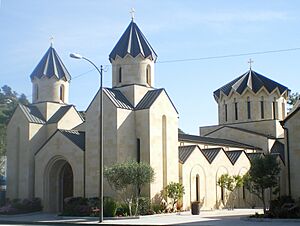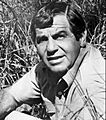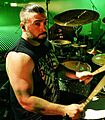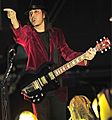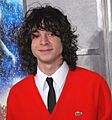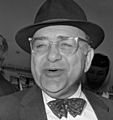History of Armenian Americans in Los Angeles facts for kids
The Los Angeles metropolitan area is home to a very large Armenian American community. In fact, as of 1990, this area had the biggest Armenian population outside of Armenia itself! Many people consider Los Angeles a special place for Armenian culture. Since 1965, most Armenians moving from Iran or the former Soviet Union have chosen to live in Los Angeles. Armenians are a big part of the local Middle Eastern population there.
Contents
History of Armenians in Los Angeles
Early Settlers and Big Changes
The first Armenian families started settling in Los Angeles in the late 1800s. One of the very first Armenians arrived around 1900. He was a student who moved from the East Coast for health reasons. Another early Armenian was a seller of Oriental rugs.
A large number of Armenians came to Los Angeles because of the Armenian genocide. This terrible event happened during the break-up of the Ottoman Empire. Most early Armenian settlers were from a region called Western Armenia, which is now part of eastern Turkey. Around 1923, there were about 2,500 to 3,000 Armenians in Los Angeles. By the mid-1920s, more Armenians settled in the Pasadena area. In 1924, a group of 20 young Armenians formed the Varoujan Club. They wanted to organize Armenian cultural and social events. During this time, important groups like the Armenian General Benevolent Union (AGBU) were also started. By 1933, Pasadena had 120 Armenian families. Most of these immigrants were from the Ottoman Empire. They settled near Allen Avenue and Washington Boulevard, using a local church for their gatherings.
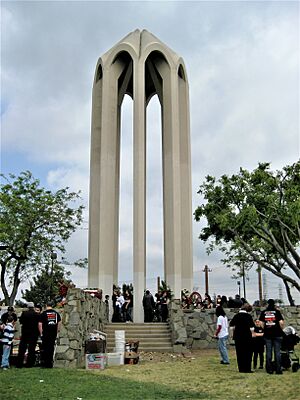
Another wave of Armenians came to Los Angeles in the 1940s. Many settled in Little Armenia in Hollywood. The Montebello Genocide Memorial was opened in Montebello in 1968. This memorial helps people remember the Armenian Genocide.
Later Arrivals in the 1900s
The Lebanese Civil War started in 1975. This led to more Lebanese Armenians moving to Los Angeles. Other conflicts also caused Iranian Armenians and Egyptian Armenians to settle there. Armenians from other parts of the U.S., like Fresno and the East Coast, also moved to Los Angeles. They were drawn by the large Armenian community already living there.
About 9,500 Armenians came to the United States in 1979 and 1980. Most of them settled in Hollywood. In 1987, the Soviet Union started allowing Armenians to leave. This was part of a new policy called glasnost, which meant more openness. Many wanted to join their relatives in the U.S. From late 1987 to early 1988, 2,000 Armenians arrived in Los Angeles County. Officials expected 8,000 more to come. This was one of the biggest groups of people arriving at once since the late 1970s. This wave of immigration helped create Little Armenia in Hollywood.
By 1988, up to 3,000 Iranian Armenians were expected in Los Angeles. From 1987 to 1989, 90% of Armenians leaving the Soviet Union settled in Los Angeles. More Armenians moved to Los Angeles in the 1990s due to conflicts in the former Soviet Union.
21st Century Armenian Community
In 2010, basketball star Kobe Bryant signed a deal with Turkish Airlines. Armenians in Los Angeles protested this. They asked him to end the contract. This was because the Turkish government does not recognize the 1915 genocide.
By 2014, Los Angeles welcomed more Armenian refugees. These new arrivals came from Egypt and Syria. The ongoing Syrian civil war caused this recent wave of refugees.
In 2015, over 130,000 people took part in the 2015 Armenian March for Justice. They marched from Little Armenia to the Turkish Consulate in Los Angeles. They demanded recognition and justice for the Armenian Genocide. This march happened on the 100th anniversary of the tragedy.
An Armenian Genocide memorial opened in Grand Park in September 2016.
Where Armenians Live in Los Angeles
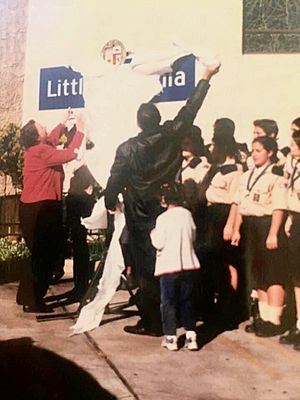
The main areas where Armenians settled are Burbank, Glendale, East Hollywood, Montebello, and Pasadena. In 1980, these areas were home to 90% of Armenians in Los Angeles County. Armenians have become one of the largest ethnic groups in Los Angeles. By 1991, other Armenian communities were in Encino and Hollywood. The Burbank/Glendale area is a newer settlement spot.
Little Armenia in Hollywood historically had many Armenians from Armenia. In 1980, Armenians in East Hollywood made up 56% of all Armenians in Los Angeles County. Hollywood became a "port of entry" for Soviet refugees. In 1988, people in Yerevan, Armenia, would often say, "'Going to Hollywood, going to Hollywood.'" Little Armenia had many Armenian bakeries and apartments above businesses. Zankou Chicken, a famous Armenian restaurant, opened in Hollywood in 1984.
In 1980, Armenians in Glendale made up 25% of Armenians in Los Angeles County. By 1988, Armenian students became the largest ethnic group in the Glendale Unified School District. This was more than Latino students. Glendale attracted more Armenians because it was in the middle of other Armenian communities. By the early 1990s, Glendale's Armenian population grew larger than Hollywood's. In 2000, 30% of Glendale's residents were Armenian. Glendale had the largest Armenian population outside of Yerevan.
Historically, many U.S.-born Armenians settled in Montebello and Pasadena. In 1980, Armenians in Pasadena were 9% of the county's total. By 1989, the Armenian community in Pasadena had changed. About 33% were born in Lebanon, 17% in the U.S., 16% in Armenia, and 12% in Syria.
By 1988, many Armenians were moving from Hollywood to suburbs like Glendale and Burbank. Some immigrants settled directly in Glendale and Burbank. Many Glendale Armenians historically came from Iran.
On October 6, 2000, the Los Angeles City Council officially named the community in East Hollywood "Little Armenia." The city council noted that the area had many Armenian businesses, residents, and cultural places. These included schools, churches, and social groups.
Armenian Culture in Los Angeles
The Armenian American Museum is being built in Glendale. This large museum will be nearly 60,000 square feet. It was designed by local Armenian architects. The building's design looks like Mount Ararat and the Verdugo Mountains around Glendale. The museum will have an auditorium and a kitchen for cooking demonstrations.
Religion
Many Armenians in Los Angeles follow the Armenian Apostolic Church. In 1994, Karekin II, a leader of the Holy See of Cilicia, visited Los Angeles. At that time, about 300,000 Armenians in Southern California were part of the Armenian Apostolic Church.
In 2005, both Karekin II and Aram I, leaders of different branches of the Armenian Apostolic Church, visited Los Angeles. They hoped for more teamwork between their churches.
Some Armenians are Catholic. In 1951, a Catholic Armenian leader visited Los Angeles. That same year, a priest helped start a local Armenian Catholic church. Our Lady Queen of Martyrs in Boyle Heights became the center of Catholic Armenian life. However, since 2001, St. Gregory the Illuminator Cathedral in Glendale has become more important.
Armenian Population Details
The Armenian population in Los Angeles is very diverse. People come from different countries, and each group has its own culture. These groups include Armenians born in the United States, Iranian Armenians, Lebanese Armenians, and Turkish Armenians. There are also Armenians from other parts of the former Soviet Union and the Middle East.
A study in 1923 found about 2,500 to 3,000 Armenians in Los Angeles. Most were Turkish Armenians, with some from Russia. The main reason Armenians moved was the Armenian genocide. Many Armenians ended up in countries like Iran, Syria, Lebanon, and Egypt.
During the 1970s, many Armenians came to the U.S. from Lebanon, Egypt, and Iran. They often came to reunite with their families. Immigration was very high in the 1970s. By 1980, about 66% of all Armenian immigrants had arrived between 1975 and 1980.
In 1980, the average age of U.S.-born Armenians in Los Angeles was 25. Turkish Armenians were the oldest group, with an average age of 64. They had lived in the U.S. the longest. Other Armenian groups had average ages between 26 and 36.
By 1980, there were 52,400 Armenians in Los Angeles. However, experts believe this number was actually higher. More than twice as many Armenians were born outside the U.S. (37,700) compared to those born in the U.S. (14,700). Of those born outside the U.S., many came from Iran (7,700), the former Soviet Union (7,500), Lebanon (6,000), and Turkey (5,100).
By 1990, there were 115,000 Armenians in the Los Angeles area. This made up 37% of all Armenians in the entire country.
Politics and Armenian Americans
Many younger Armenian Americans are getting involved in politics. This is partly because the Armenian genocide is not recognized by some countries. One of their achievements is getting April 24, the start of the Genocide, recognized as a day of remembrance. They have also helped create exhibitions, books, and conferences.
In 2006, Paul Krekorian was elected to the California State Assembly. In 2009, Krekorian won a seat on the Los Angeles City Council. In 2022, he was elected president of the Los Angeles City Council.
As of 2023, three out of five members of Glendale's City Council are of Armenian descent. These include Ardy Kassakhian, Elen Asatryan, and Ara Najarian.
Armenian Economy in Los Angeles
Armenians in Los Angeles are known for being good at business. As of 1996, over 66% of Armenian managers and professionals in Los Angeles owned their own businesses.
In 1980, 25% of Armenian men aged 16 and older worked as executives and professionals. 44% worked as skilled workers and operators. Armenian men from Armenia were less likely to start their own businesses. This is because they came from a different economic system and often had little money when they arrived.
A 1923 study found that about 39.5% of Los Angeles Armenians were skilled workers. 23.5% worked in farming. Only 2.3% were professionals.
Armenian Media
As of 2013, Glendale had eight Armenian-American TV stations. It also had at least ten Armenian-American newspapers.
- Asbarez is a newspaper published daily in Armenian and English. It means "Arena."
- The California Courier has been published weekly in Glendale since the 1980s.
- Massis Weekly is an official publication of the Social Democrat Hunchakian Party. It is published in Pasadena.
- Nor Hayastan is an independent Armenian language daily newspaper. It means "New Armenia" and is published in Glendale.
- Nor Or is an independent Armenian language weekly newspaper. It means "New Day" and is published in Altadena.
Other important Armenian media in Los Angeles include:
- Horizon Armenian Television, the first 24-hour Armenian TV network in America.
- PanArmenian TV, created in 2012 for Armenian Americans.
- In 2014, USArmenia started airing Glendale Life. This was a reality TV show about Armenians in Glendale. Some people did not like the show and started online petitions against it.
- KLOS-HD3 plays Armenian music and is known as "SoCal Armenian."
Education for Armenians
In 1980, Armenians in Los Angeles generally had a good level of education. However, different groups of Armenian immigrants had different education levels. For example, almost all U.S.-born Armenian men had university degrees. But almost half of older Turkish Armenian men had only some elementary school education.
In June 2021, Adrin Nazarian announced $9 million in state money. This money will help create a TUMO Center for Creative Technologies in the San Fernando Valley. TUMO Centers teach creative skills using technology. Serj Tankian, a famous musician, said the Los Angeles center will be in North Hollywood. He believes it will be great for creative fields like acting and filmmaking.
Schools for Armenian Students
Public Schools In 1990, Armenians were the largest immigrant group speaking a language other than English in the Glendale Unified School District. By 2004, over 33% of students in the Glendale district were Armenian. The district even thought about making Armenian holidays school holidays. In 2016, the Glendale district became the first American school district to close on April 24. This day is the anniversary of the start of the Armenian genocide.
In 2010, 20% of students at Grant High School in Valley Glen were Armenian.
Armenian Schools
As of 1993, there were twelve Armenian day schools in the Los Angeles area. Five of these were high schools. Most Armenian day schools in the United States are in Los Angeles. Ferrahian Armenian School in Encino, Los Angeles was the first Armenian day school in the U.S., opening in 1964.
- The Rose and Alex Pilibos Armenian School is in Little Armenia in Hollywood.
- Armenian schools in the San Fernando Valley include the AGBU Manoogian-Demirdjian School in Winnetka. There is also the Ferrahian Armenian School in Encino and North Hills.
- The PK-12 Armenian Mesrobian School is in Pico Rivera. It serves the Armenian community east of Downtown Los Angeles.
- Armenian schools in Glendale include the Chamlian Armenian School.
Some Armenian schools have closed, like TCA Arshag Dickranian Armenian School in 2015 and AGBU Vatche and Tamar Manoukian High School in 2020.
Higher Education Mashdots College is in Glendale. It offers college, career, and certificate programs.
Armenians and Other Communities
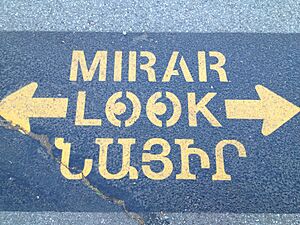
More and more different groups, like Armenians, Cubans, Filipinos, and Koreans, started living in Glendale. This changed how the city talked about its population. In 1972, a city manager encouraged the Rotary Club to prepare for a more diverse city.
During the 1992 Los Angeles uprising, Armenians mostly stayed in their own communities. A police officer noted that Armenians had a history of staying separate. He said, "The more we cooperate with and learn about other communities, the better it is for everyone."
Sometimes, new Armenian immigration caused problems. In 2000, there were some violent incidents in Los Angeles. These were due to tensions between Armenians and Latinos.
In January 2019, someone put Turkish flags on the gates of two Armenian schools. Authorities investigated these incidents, which worried the local Armenian community.
In November 2020, during a conflict called the Second Nagorno-Karabakh War, the Mexican community in Glendale showed support for Armenians. They set up a Day of the Dead altar.
In 2022, a scandal involving the Los Angeles City Council happened. A council president made a disrespectful comment about an Armenian advisor. The Armenian National Committee of America spoke out against this.
In 2022, people protesting a blockade in Artsakh found hateful flyers near the Turkish Consulate in Los Angeles. Local officials, including President of the Los Angeles City Council Paul Krekorian, quickly spoke out against these flyers.
School Conflicts
For many years, Latinos were the main minority group in Glendale. But by 2000, Armenians became the new "majority minority." During this time, Herbert Hoover High School had problems with violence between Latino and Armenian students. This led to the death of a student in 2000. In 2018, another fight caused a football game between Hoover High and Glendale High School to be canceled.
At Ulysses S. Grant High School, a fight between an Armenian girl and a Latina girl grew into a fight involving 200 students in 1999. Forty students were held, and ten students and some staff were hurt. In January 2000, students signed a "peace treaty" to stop future fighting. Banners promoting peace were put up. By October, programs were held to reduce tension. However, ethnic tensions flared up again in 2005, with a fight involving nearly 500 students. By 2019, Grant High had become a school with mostly Armenian students.
Notable Armenian Residents
-
Tatev Abrahamyan (a top chess player)
-
Ben Agajanian (an American football player)
-
Armenchik (a singer)
-
Ross Bagdasarian Sr. (a singer and songwriter)
-
Chaz Bono (a writer, musician, and actor)
-
George Deukmejian (a former Governor of California)
-
John Dolmayan (drummer for System of a Down)
-
Albert and Allen Hughes (film directors)
-
Khloé Kardashian (TV personality)
-
Kim Kardashian (TV personality and businesswoman)
-
Kourtney Kardashian (TV personality)
-
Ana Kasparian (a political commentator)
-
Kirk Kerkorian (a famous businessman)
-
Daron Malakian (guitarist for System of a Down)
-
Yura Movsisyan (a former footballer)
-
Shavo Odadjian (bassist for System of a Down)
-
Armen Ra (a thereminist)
-
Angela Sarafyan (an actress)
-
Cher (Cherilyn Sarkisian) (a famous singer)
-
Alexander Sarkissian (a tennis player)
-
Edmen Shahbazyan (a mixed martial artist)
-
Akim Tamiroff (an actor)
-
Serj Tankian (singer for System of a Down)
-
Michael Vartan (an actor)



